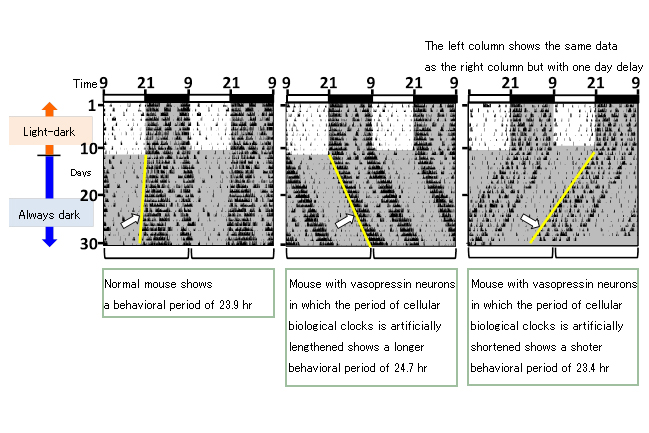Abstract:
Vasopressin-producing neurons have been found to determine the period length of the biological clock that generates circadian rhythm (the length of a day for the individual organism). Because most of the functions of our body are under control of the biological clock, the present finding is expected to contribute to therapy and remedy of various diseases/health problems related to disturbances of the biological clock, such as sleeping disorders, mental disorders, and metabolic syndromes.
Behaviors and functions of the body of mammals are under control of the circadian rhythm, a cycle of ca. 24 hours. Those functions include body temperature, secretion of hormones, autonomic functions and so on. The circadian rhythm is controlled by the biological clock in the suprachiasmatic nucleus, a part of the hypothalamus of the brain. It also determines approximate pattern of activities such as the time of awaking and that of falling asleep. If the biological clock goes different from the local time, various problems arise. Jet lag is thought to be perceived when the biological clock is difficult to be adjusted to the local time. Furthermore, disturbance of the circadian rhythm due to night shift, for example, may cause sleeping disorders as well as augmentation of risks of various mental disorders, cancer and metabolic syndromes. Therefore, understanding of the mechanism of the circadian rhythm and development of method (medication) to control the biological clock are of primary significance for those living in the modern society where maintaining adequate daily rhythm is not easy.
The suprachiasmatic nucleus consists of ca. 20,000 neurons. These neurons are not homogeneous but are a mixture of various types with different characteristics. Many of them form networks and communicate one another, and the suprachiasmatic nucleus as a whole delivers the time information to every part of the body. So far, some scientific reports claim that certain neurons of the suprachiasmatic nucleus determine the biological clock (length of a day), but those neurons inferred consist of various types of cells. Thus, it was unclear which neurons would be responsible for determining the period length of the biological clock.
In this study, the researchers of Graduate School of Medical Sciences, Kanazawa University, in collaboration with researchers of Riken have discovered for the first time that among neurons of the suprachiasmatic nucleus, those producing vasopressin, vasopressin neurons, determine the period length of the biological clock. The researchers have manipulated vasopressin neurons to have its biological clock on a longer period by genetic modification, and the mice thus modified exhibited one hour longer period of behavioral rhythm. On the contrary, the mice showed 30 min shorter behavioral period, when the vasopressin neurons were manipulated to have shorter period on the biological clock.
When the period length on the biological clock deviates from 24 hours to a significant extent, it becomes difficult to adjust to the daily cycle of 24 hours. There are so-called night persons (active at night but inactive in the morning) who are considered to have a problem in terms of the biological clock. On the other hand, jet lag is caused by the difference of the biological clock and the local time (phase difference). With age, it gets difficult to have sound sleep, for which insufficient effect of the biological clock is thought to be responsible. The research team previously observed that the vasopressin neurons were able to make the effect of the biological clock larger. Comprehension of the mechanism of the biological clock, that is, how the period length, phase and effect are controlled, is important in finding most appropriate therapeutic methods for diseases and disorders caused by disturbance of the biological clock.
The research results were published online in Current Biology, a scientific journal issued in the United States, on August 25, 2016.


Circadian behavioral rhythm
Thin vertical lines indicate that the mouse moved at that moment. Mice are nocturnal, being active at night. Even under totally dark condition (all the day without light), mice show clearly observable circadian rhythm, because of the functions due to the biological clock. However, depending on the period of rhythm produced by vasopressin neurons, the period of behavioral rhythm varies. In the case of the solid line indicated by arrows being vertical, the period is 24 hours.
Article
Title: Manipulating the Cellular Circadian Period of Arginine Vasopressin Neurons Alters the Behavioral Circadian Period.
Journal: Current Biology
Authors: Michihiro MIEDA1, Hitoshi OKAMOTO2, Takeshi SAKURAI1
1Kanazawa University, 2RIKEN Brain Science Institute
Doi: http://dx.doi.org/10.1016/j.cub.2016.07.22
Funder
Grants-in-aid for Scientific Research 24390052, 15K15039, 16H05120 and 16H01608 from JSPS, MEXT, a grant from Takeda Science Foundation, a grant from the Brain Science Foundation and a grant from Ichiro Kanehara Foundation.



 PAGE TOP
PAGE TOP